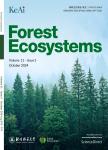Re-estimating the changes and ranges of forest biomass carbon in China during the past 40 years
Re-estimating the changes and ranges of forest biomass carbon in China during the past 40 years作者机构:Research Center for Ecological Forecasting and Global ChangeNorthwest A&F UniversityYangling 712100China Ecological Modeling and Carbon ScienceDepartment of Biology ScienceUniversity of Quebec at MontrealMontrealQC H3C 3P8Canada Institute of Forest Resource Information TechniquesChinese Academy of ForestryBeijing 100091China State Key Laboratory of Remote Sensing ScienceInstitute of Remote Sensing and Digital EarthChinese Academy of SciencesBeijing 100101China Faculty of Health SciencesUniversity of OttawaOttawaON K1N 6N5Canada.
出 版 物:《Forest Ecosystems》 (森林生态系统(英文版))
年 卷 期:2019年第6卷第4期
页 面:396-413页
核心收录:
学科分类:08[工学] 081101[工学-控制理论与控制工程] 0811[工学-控制科学与工程] 081102[工学-检测技术与自动化装置]
基 金:supported by the National Key Research and Development Program of China(Grant Nos:2017YFA0604401,2016YFC0501101) the Open Fund of State Key Laboratory of Remote Sensing Science(No.OFSLRSS201704) the Meteorology Scientific Research Fund in the Public Welfare of China(No.GYHY201506010) partly supported by the National Basic Research Program in China(No.2013CB956602)
主 题:Allometric equation Forest carbon Stem-biomass proportion Volume-derived method Wood density
摘 要:Background: In recent decades the future of global forests has been a matter of increasing concern, particularly in relation to the threat of forest ecosystem responses under potential climate change. To the future predictions of these responses, the current forest biomass carbon storage(FCS) should first be clarified as much as possible,especially at national scales. However, few studies have introduced how to verify an FCS estimate by delimiting the reasonable ranges. This paper addresses an estimation of national FCS and its verification using two-step process to narrow the uncertainty. Our study focuses on a methodology for reducing the uncertainty resulted by converting from growing stock volume to above-and below-ground biomass(AB biomass), so as to eliminate the significant bias in national scale ***: We recommend splitting the estimation into two parts, one part for stem and the other part for AB biomass to preclude possible significant bias. Our method estimates the stem biomass from volume and wood density(WD), and converts the AB biomass from stem biomass by using allometric ***: Based on the presented two-step process, the estimation of China’s FCS is performed as an example to explicate how to infer the ranges of national FCS. The experimental results demonstrate a national FCS estimation within the reasonable ranges(relative errors: + 4.46% and-4.44%), e.g., 5.6–6.1 PgC for China’s forest ecosystem at the beginning of the 2010 s. These ranges are less than 0.52 PgC for confirming each FCS estimate of different periods during the last 40 years. In addition, our results suggest the upper-limits by specifying a highly impractical value of WD(0.7 t·m-3) on the national scale. As a control reference, this value decides what estimate is impossible to achieve for the FCS ***: Presented methodological analysis highlights the possibility to determine a range that the true value could be located in. The two-ste



